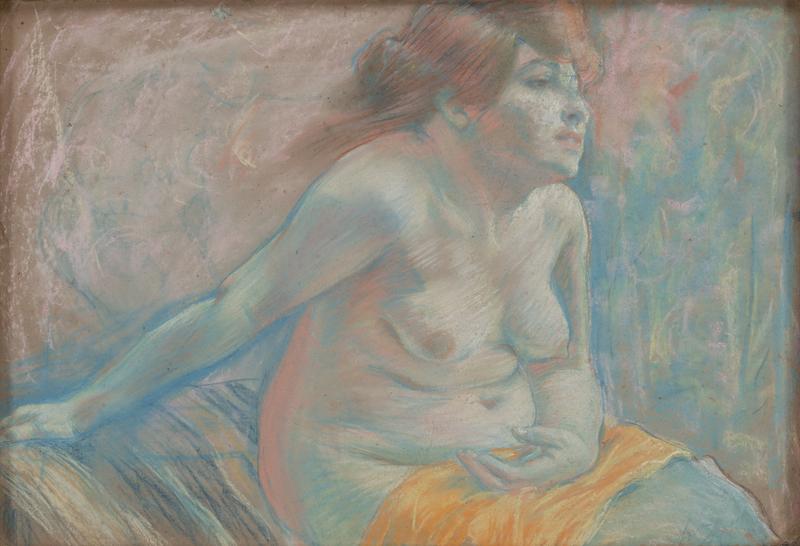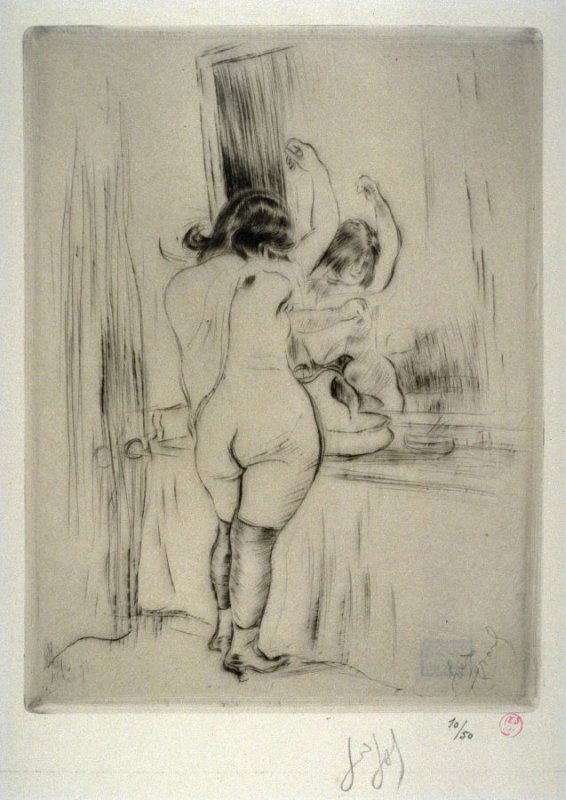
104. Louis Legrand, Nude Woman
| Artist | Louis Legrand, French, Dijon 1863–Livry-Gargan, Seine-Saint-Denis 1951 |
| Title, Date | Nude Woman (Femme dénudée), c. 1900 |
| Medium | Pastel on cardboard |
| Dimensions | 20 × 29 1/8 in. (50.8 × 74 cm) |
| Inscriptions + Marks | Lower right: Louis / Legrand |
| Provenance | Collection Hulin de Loo (Ghent, Belgium, 1862–1945). [Mathieu Néouze, Paris, until 2018; to Weisberg]; Yvonne and Gabriel Weisberg, Minneapolis (2018–21; given to Mia) |
| Exhibition History | "Reflections on Reality: Drawings and Paintings from the Weisberg Collection," Mia, 2022–23 |
| References | Virginia Gamna and Mathieu Néouze, "Tableaux-dessins-sculptures 1880–1910" (exh. cat.), Mathieu Néouze, Paris (November 2017), pp. 18–19, no. 7, ill. |
| Credit Line | Gift of Dr. Gabriel P. and Yvonne M.L. Weisberg 2021.131.1 |
Late in 1895, trendsetting Parisian gallerist Siegfried Bing opened his exquisite Maison de l’Art Nouveau.1 One of the gallery’s first one-person exhibitions showcased Louis Legrand, whose prolific output of paintings, pastels, watercolors, and prints had assured him a significant place in fin de siècle France. Perhaps more important for Bing, Legrand was controversial. His art challenged accepted mores of sexuality. The artist Félicien Rops had gained notoriety with sexually uninhibited images in the same period, and Bing sought similar buzz with Legrand. Many collectors knew of Legrand’s sensual prints (he learned printmaking from Rops), but his pastels along these lines were known mostly to private connoisseurs.

Many of Legrand’s pastels convey an atmosphere of experimentation. Much like his contemporary Edgar Degas, Legrand used pastels in original ways, evident here in his scrawls, swirls, smudges, and mixing of colors. Also like Degas, Legrand looked to the Parisian brothels for his subjects, whom he often depicted during intimate moments. This pastel, executed in lurid pinks and blues with a slash of yellow, sets the woman aglow during a moment of rest.
One of Legrand’s most avid collectors was Gustave Pellet (1859–1919), a print and book publisher with a penchant for erotic content who systematically purchased Legrand’s pastels;2 the artist produced many in the vein of Nude Woman. As a print publisher, Pellet issued more than 300 images by Legrand (fig. 1), as well as prints by Rops and Henri de Toulouse-Lautrec. Despite having been jailed briefly for the obscenity of some of his work, Legrand was made a knight of the Legion of Honor in 1906. His success proved fleeting, however, and he died, largely forgotten, in 1951.3
GPW
Notes
On Bing, see Gabriel P. Weisberg, Art Nouveau Bing: Paris Style, 1900 (New York: Harry N. Abrams, 1986); and Gabriel P. Weisberg, Edwin Becker, and Évelyne Possémé, eds., The Origins of L’Art Nouveau: The Bing Empire (Amsterdam: Van Gogh Museum, 2004). ↩︎
Virginia Gamna and Mathieu Néouze, Tableaux-Dessins-Sculptures 1880–1910 (exh. cat.), Mathieu Néouze, Paris (November 2017), p. 18. ↩︎
For a study of Legrand’s work, see Victor Arwas, Louis Legrand: Catalogue raisonné (London: Papadakis, 2006), published in conjunction with an exhibition at the Musée Félicien Rops, Namur, Belgium. ↩︎